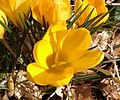Crocus
Crocus is a genus of perennial flowering plants, native to a large area from coastal and subalpine areas of central and southern Europe (including the islands of the Aegean), North Africa and the Middle East, across Central Asia to western China. The genus Crocus is placed botanically in the iris family (Iridaceae). There are about eighty species, of which approximately 30 are cultivated.
The name of the genus is derived from the Latin adjective crocatus, meaning saffron yellow. The spice saffron is obtained from the stigmas of Crocus sativus, a fall-blooming species.
Misuses of the name crocus
"Autumn crocus" is often used as a common name for Colchicum, which is in the lily family (Liliaceae), and which has six stamens; it is also known as meadow saffron. The so-called prairie crocus (formerly Anemone patens, now Pulsatilla patens or P. ludoviciana) belongs to the buttercup family (Ranunculaceae).
True autumn crocuses
Most true autumn crocus flower in September to November in the northern hemisphere. Some flower before their leaves appear. Autumn/fall flowering species include: Crocus banaticus (syn. C. iridiflorus), C.cancellatus, C. goulimyi, C. hadriaticus, C. kotschyanus (syn. C. zonatus), C. laevigatus, C. medius, C. niveus, C. nudiflorus, C. ochroleucus, C. pulchellus, C. sativus (saffron crocus), C. serotinus, C. speciosus, C. tournefortii. Crocus laevigatus has a long flowering-period which starts in late autumn or early winter and may continue into February.
As one of the first flowers to bloom in spring, the large hybridized and selected "Dutch crocus" are popular with gardeners. However, in areas where snow and frost occasionally occur in the early spring it is not uncommon for early-flowering crocuses to suddenly wither and die from a unseasonable frost or snowfall. Most crocus species and hybrids should be planted in a sunny position, in gritty, well-drained soil, although a few prefer shadier sites in moist soil. Some are suitable for naturalising in grass. The corms should be planted about 3–4 cm deep; in heavy soils a quantity of sharp grit should be dug in to improve drainage. Some crocuses, especially C. tommasinianus and its selected forms and hybrids (such as 'Whitewell Purple' and 'Ruby Giant') seed prolifically and are ideal for naturalising. They can, however, become weeds in rock gardens, where they will often appear in the middle of choice, mat-forming alpine plants and can be difficult to remove.
The first crocus seen in the Netherlands, where Crocus species are not native, were corms brought back from the Holy Roman Emperor's ambassador to the Sublime Porte, A. Ghislain de Busbeq, in the 1560s. A few corms were forwarded to Carolus Clusius at the botanical garden in Leiden. By 1620, the approximate date of Ambrosius Bosschaert's painting (illustration, left), new garden varieties had been developed, such as the cream-colored crocus feathered with bronze at the base of the bouquet, similar to varieties still in the market. Bosschaert, working from a preparatory drawing to paint his composed piece, which spans the whole of Spring, exaggerated the crocus so that it passes for a tulip, but its narrow, grasslike leaves give it away. Species
Description
[edit | edit source]The plants grow from corms and are mainly hardy perennials, and are found a wide range of habitats, including woodland, scrub and meadows.
Their cup-shaped, solitary, salverform flowers taper off into a narrow tube. Their color varies enormously, although lilac, mauve, yellow and white are predominant. The grass-like, ensiform leaf shows generally a white central stripe along the leaf axis. The leaf margin is entire. All crocuses typically have three stamens.
The taxonomic characteristics are based mainly on the presence or absence of a prophyll (a basal spathe) and the aspect of the style and the corm tunic.
Growing Conditions
[edit | edit source]Species
[edit | edit source]1 Subgenus Crocus
- A. Section Crocus
- Series Kotschyani
- Crocus autranii
- Crocus gilanicus (discovered in 1973 and named after Gilan province in Iran where it was first found)
- Crocus karduchorum
- Crocus kotschyanus
- Crocus ochroleucus
- Crocus scharojanii
- Crocus vallicola
- Series Kotschyani
- Series Longiflori

- Series Scardici
- Series Verni


- Crocus baytopiorum
- Crocus etruscus
- Crocus kosaninii
- Crocus tommasinianus
- Crocus vernus : spring crocus, Dutch crocus
- Series Versicolores
- Series Crocus
- Crocus sativus : saffron crocus (a sterile triploid mutant)
- Series Crocus
- B. Section Nudiscapus
- Series Aleppici
- Series Biflori
- Series Carpetani
- Series Flavi
- Series Intertexti
- Series Laevigatae
- Series Orientales
- Series Speciosi
- Crocus speciosus : autumn crocus
- Crocus pulchellus
- Series Speciosi
2. Subgenus Crociris
Uses
[edit | edit source]Maintenance
[edit | edit source]Propagation
[edit | edit source]Harvesting
[edit | edit source]Pests and diseases
[edit | edit source]- Scab caused by Pseudomonas marginata Gladiolus scab
Fungi:
- Dry Rot caused by Stromatinia gladioli
- Corm Rot caused by Fusarium oxysporum
- Blue Mold caused by Pennicilium spp.
Viri:
- Mosaic caused by Iris Mosaic Virus
- Green Peach Aphid: Myzus persicae
- Tulip Aphid: Dysaphis tulipae
- Bulb Mite: Rhizoglyphus echinous
- Deer will definitely browse crocus
- Birds sometimes take the flowers
- Voles, mice, and squirrels eat the bulbs.
Gallery
[edit | edit source]-
Wild crocus growing in the foothills of the Eiger in the European Alps.
-
Crocus vernus 'Pickwick', a Dutch hybrid
-
Crocus 'E.A. Bowles',
a Chrysanthus hybrid -
Crocus cultivars
References
[edit | edit source]- Brian Mathew, Christopher Grey-Wilson, Bulbs, (ill. Marjorie Blamey), Collins, 1981
- Brian Mathew, Crocus: A Revision of the Genus Crocus, Timber Press, 1983. ISBN 0-917304-23-3
- Brian Mathew, Flowering Bulbs for the garden, Collingridge/Royal Botanic Gardens, Kew, 1987. ISBN 0-600-35175-0




